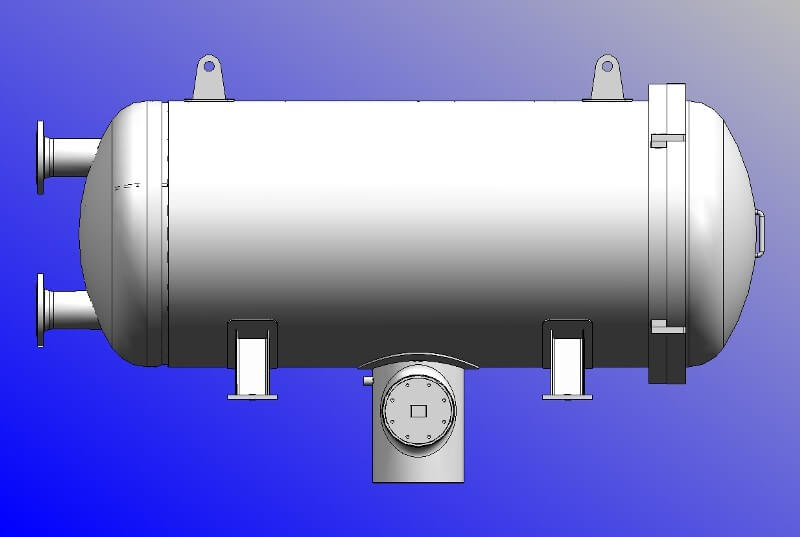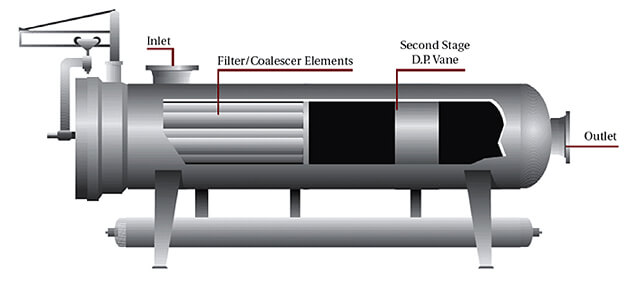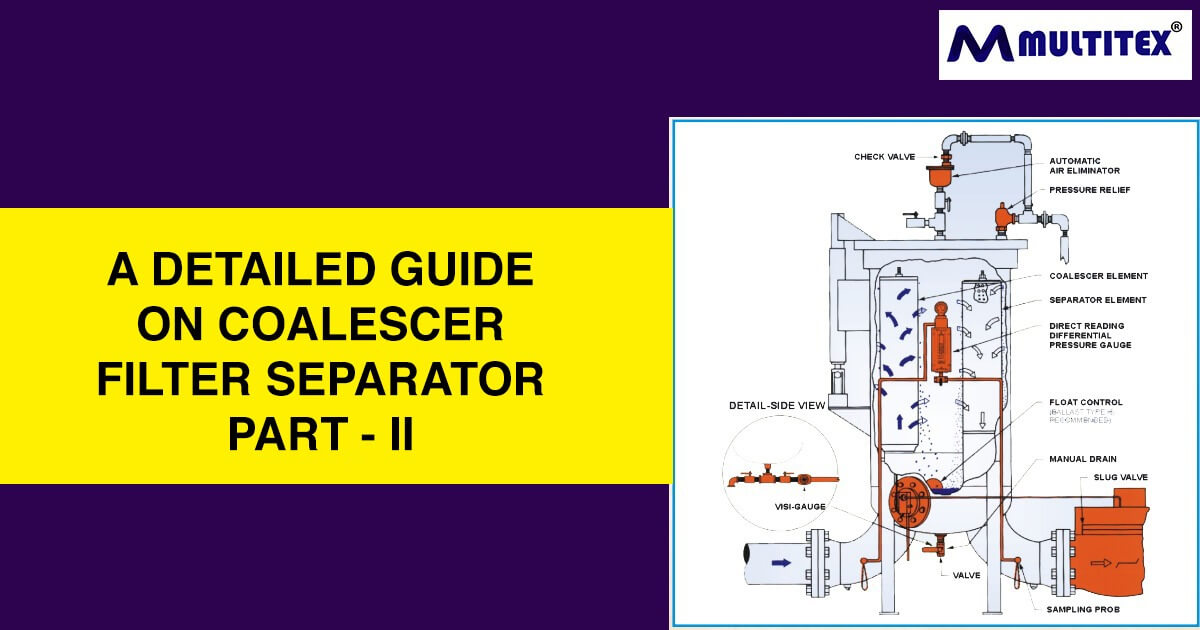Coalescer Filter Separator is a two-stage, vertical separation vessel designed to separate liquid that exists in the form of a fine mist or fog, as well as solid particles, from a gas or vapor.
This framework works in two phases to eliminate the dust from the air, gas, or steam lines- the coalescer and separation/detachment stages. The unit includes a Vortex Containment Plate placed to prevent the remaining fluids and solids from being re-entrained into the stream and guide them toward the channel.
This process is used fundamentally in applications where fine fogs occur with other procedures including cooling, buildup, flashing, or evaporation. Some examples are compacted refrigeration gases, high pressing factor gas at infusion wells, fuel gas lines to motors in power and modern plants, and steam lines.
What are the significant contaminants that a Coalescer Filter Separator Remove?

The main work of this Coalescer Filter Separator is to remove unwanted materials from the useable substances. So, these unwanted materials or contaminants pre-exist in the substance before going through Coalescer Filter Separator.
A filter separator will remove various types of contaminants, including the oil and water contaminants present in the pre-treated gas and liquid.
Let’s explore both of the contaminants separately.
- Water
Three kinds of water are present in the treated substance. They include:
- Free water: This is the excess water that stays after the treated gas or fluid has dissolved water to the total limit. You will see free water illuminate regarding a haze when it outperforms 30 to 40 ppm.
- Entrained/Emulsified water: This is discrete water that glides in the liquid stream. It comes because of build-up or different uses/ employments of water in the system.
- Dissolved water: This kind of water is blended in with the process liquid and isn’t noticeable. The amount of dissolved water is relative to water temperature, and hotter liquids hold more dissolved water.
- Oil
Oil can discover its way into the water through various strategies.
The thickness of the oil ought to be low for professional removal after using coalescing filter separators.
There are various types of oil that contaminate the processed liquid.
They incorporate free, solubilized, scattered, molecularly dissolved, artificially emulsified, and suspended solids covered with oil.
Best Material for the production of Coalescer Filter Separator Housing?
Coalescing filter separator housing is quite possibly the most crucial segment of a channel.
You can choose the material of construction from a broad scope of alternatives accessible.
Some of the generally used materials include:
- Carbon steel
- Copper and nickel
- Aluminum
- Types of Stainless steel
- Monel
- Cast iron
- Nickel
Construction of the equipment is as important as considering some other factors while choosing these materials. Let’s discuss the other factors that we should consider while selecting these given materials:
Synthetic or Chemical Properties of Process Fluid and Contaminants
The production material should be viable with the processed liquid and foreign substances or contaminants you are filtering out.
You can use hardened steel for profoundly corrosive liquids since it has molybdenum which makes it exceptionally resistant to corrosion.
Then again, you can cover a material promptly eroded with an inert layer to the process liquid.
Working Conditions for the Application
You will require solid material to construct filter housing where the treated application is harsh, like in the petroleum gas mining businesses.
Under such conditions, you should choose a sturdy material with solid elasticity.
High tensile carbon steel and tempered steel will offer feasible alternatives.
Other Requirement of the Application
A few applications that require sterile conditions have exceptional neatness guidelines that the material needs to stick to.
Stainless steel is the best material decision when neatness is of essential concern.
In any situation where the application requires lightweight filter channels, you can use aluminum. However, this Material can undoubtedly break under unfavorable conditions and is additionally inclined to corrosion.
Cost
The possession cost of construction material is important too but effectiveness is always the priority.
Stainless steel costs more than other materials yet gives fulfilling results.
Choosing a cheaper alternative for your process application is going to end up costing time, money, and effort in the process. It is a wise move to pick a quality separator instead..
For how long will a Coalescer Filter Separator Element last?
A Coalescer Filter Separator is undoubtedly expensive to manage and control.
The service or assistance life of Coalescer Filter Separator and isolating cartridges in a filter separator relies upon many things.
In any case, the cartridges may not last over a year under operation in any event when the change-out pressure differential has not been reached.
Materials used for Coalescer Filter Separator Media
The separator media is divided into two particular parts, filter cartridge and separator cartridge. These cartridges work differently and use different materials too.t.
Coalescing Filter Media
The Coalescing filter/channel media can be manufactured professionally using synthetic materials.
The media of mixing or coalescing channel uses hydrophilic process (water-adoring) in case of the presence of coalescing water drops and oleophilic (oil-cherishing) in case of the prescence of coalescing oil drops.
Some regular examples of hydrophilic materials are fiberglass and treated steel, while oleophilic materials incorporate polypropylene and fluoropolymers.
You can likewise use cellulose which is a natural material.
You can also use nylon to make a coalescer filter separator to remove water, amine, and burning from hydrocarbons and eliminate water from solid solvents.
For gas-fluid coalescing filter separators, you can use fiberglass, nylon, polyester, and tempered steel.
Separator Filter Media
The Material for making the separator media will fluctuate depending upon the type of toxin you need to remove.
The materials ought to be repellant to the pollutions being taken out.
Division of water will require a hydrophobic material while that of oil ought to be oleophobic.
Here are some of the hydrophobic materials which you can use to build a separator for repelling water droplets.
- Teflon Coated Fine Mesh
This is the most widely recognized common type of material and is exceptionally liked in many applications.
It is more reasonable for jet fuel filtration since it creates fewer static charges than different filter medium types.
The main benefit of using Teflon-covered cartridges is the capacity to reuse them with steady examination and cleaning.
- Creased Paper Cartridges
You will use these filter cartridges only once, and afterward, you need to dispose of them.
That is why they are appropriate for use when liquid filtration must adhere to the components and can’t be disposed of.
- Synthetic Media
You can use an interestingly electric woven artificial material like the filter medium.
One can clean them for a few cycles before they outlast their usefulness.
Process of Designing and Size a Coalescer Filter Separator

Coalescer Filter separator needs a huge area to settle in, so you have only two shape options to choose from.
Either you can choose a vertical filter separator or a horizontal filter separator. Likewise, the choice of the design will depend on the area volume you choose, as discussed before.
Here are some instances you must go through before deciding the right size of a Filter Separator.
The Efficiency of Filtration focused on
The effectiveness of filtration relies upon the state of the Inflowing process liquid and the output liquid.
Normally, a larger than average filtration unit gives better outcomes when the incomingliquid stream is exceptionally polluted.
The ability of Element Replacement
When using smaller filters, you should launch regular filter elements contrasted with larger size filters.
Even though the underlying unit cost of a smaller filter cartridge might be low, the combined cost of buying and substitution is much higher.
This is measured with that of bigger filters over the long run.
Additionally, your application process may not help continuous open and filter change-outs without causing significant downtown losses.
The Operating Flow Rate
The size of a channel is straightforwardly relative to the process application stream flow rate.
An application with a higher fluid flow rate requires bigger filter channels to manage the process requirements.
Cost
Before going further, you should take a quick and precise note of the operational expense of a filter when the cost is of primary concern, after including the cost related to buy, establishment, change out, labor work, and other random costs related to the use of the channel.
Factors that Influence the Performance of a Coalescer Filter Separator
There are a lot of factors that influence the performance of the Coalescer Filter Separator. Because this is an electronic mechanism, it needs assistance and maintenance to run and process the substances.
The influencing factors are-:
- The different types of solid and fluid pollutants
- Various sizes of particles and droplets
- The dirt levels in the approaching process liquid
- The size of the filter and pollutant holding limit of the filter components
- Numerous working conditions, that is, operating temperature, pressing factor, and streamflow rates
- Availability of physical properties and chemical similarity of the filtration media
- The fluctuating rating of the coalescing and separation cartridges
How can you Rate or Measure Coalescer Filter Separator?
The coalescer filter separators are evaluated or rated after using a flat-out/absolute rating or beta rating.
The total rating shows the capacity of the coalescing filter separator to take out particles of a given size.
Then again, the beta proportion rating gives the ability of the filter to discard a given level of a specific size of impurity from the liquid stream.
ISO Standards specification- Coalescer Filter Separator
The coalescing filter separator is created under ISO guidelines 9001: 2015, which encloses quality management systems.
Though various organizations have different/ selective ISO norms that determine the cleanliness levels excepted from the last treated liquid after filtration.
Other than ISO, the production and use of filter separator ought to follow these given business guidelines:
- NACE MR0175
- API 12J
- ASME Code Section VIII, Div.1
- UL, Exp
- CE
- PED
- ANSI B31.3 Class M (H2S)
- API 6A, API 6D
How do you Clean a Coalescer Filter Separator?
Cleaning is one of the most critical procedures a user should follow on a necessary basis. Such equipment get contaminated with rust, corrosion, junk, and other destructive bacteria over time.
So to protect your separator and its parts from this heavy monetary loss destruction, proper and necessary cleanliness is required.
Make sure you check the directions given on the cartridges to confirm that they are cleanable.
Normally, pleated paper components are not cleanable, while manufactured media cartridges can be cleaned.
Effective Measures to Maintain and Service Coalescer Filter Separator
- Ensure that the Coalescer Filter Separator is manually purged every day to ignore any system closure.
- Even though programmed filters can be less laborious to use, they can fall flat and lead to the stoppage of the process application. Handle them carefully.
- Lead regular checking of the pressure differential gauge and monitor the regular readings daily.
- Change the coalescer components when pressing factor drop signals.
When you are using Teflon covered screen separator filters, check for the following:
- Inspect for harm, test, and clean the separator cartridges mentioned by the manufacturing organization at every coalescence filter change. Hold the cartridge at a point and pour water onto the surface close to three inches from the separator surface.
- Ensure that it frames a dab and moves off the surface for an appropriate working filter.
- In any case, if there should be an occurrence of wetting of the separator cartridge, then it means it has bombed the water test and is not suitable for installation. Clean the separator and attempt once more.
- Try not to touch the outside of the separator cartridge with your bare hands before and after cleaning it. Clean, make it spotless, and dry poly-pack to hold it and reinstall after it is dry.
How will the long Coalesce Filter Separator last?
- Doreplace the filter separator cartridges when they reach the pressing factor differentials suggested by the filter manufacturer.
- It is suggested thatyou don’t use an element for more than a year.
- You may also replace or clean the separator cartridge while changing the mixing/coalescing components.
When you follow all these protocols, your filter separator can be used safely.
Conclusion
Coalescer Filter Separator is a tremendous petrochemical setup in a voluminous area to give refined valuable substances to the petrochemical manufacturing industry. This separator contains valuable chemical substances that can be launched in the market only after a complete process of filter-separator treatment.
Ultimately, the separator has many valuable features which are profoundly used while exaggerating valuable gases and liquids and constructing Coalescer Filter Separator.
To know more about the Coalescing Filter Separator and its ultimate features, visit our website.
For more information on our solutions, could you mail us at enquiry@multitexfilters.com.
